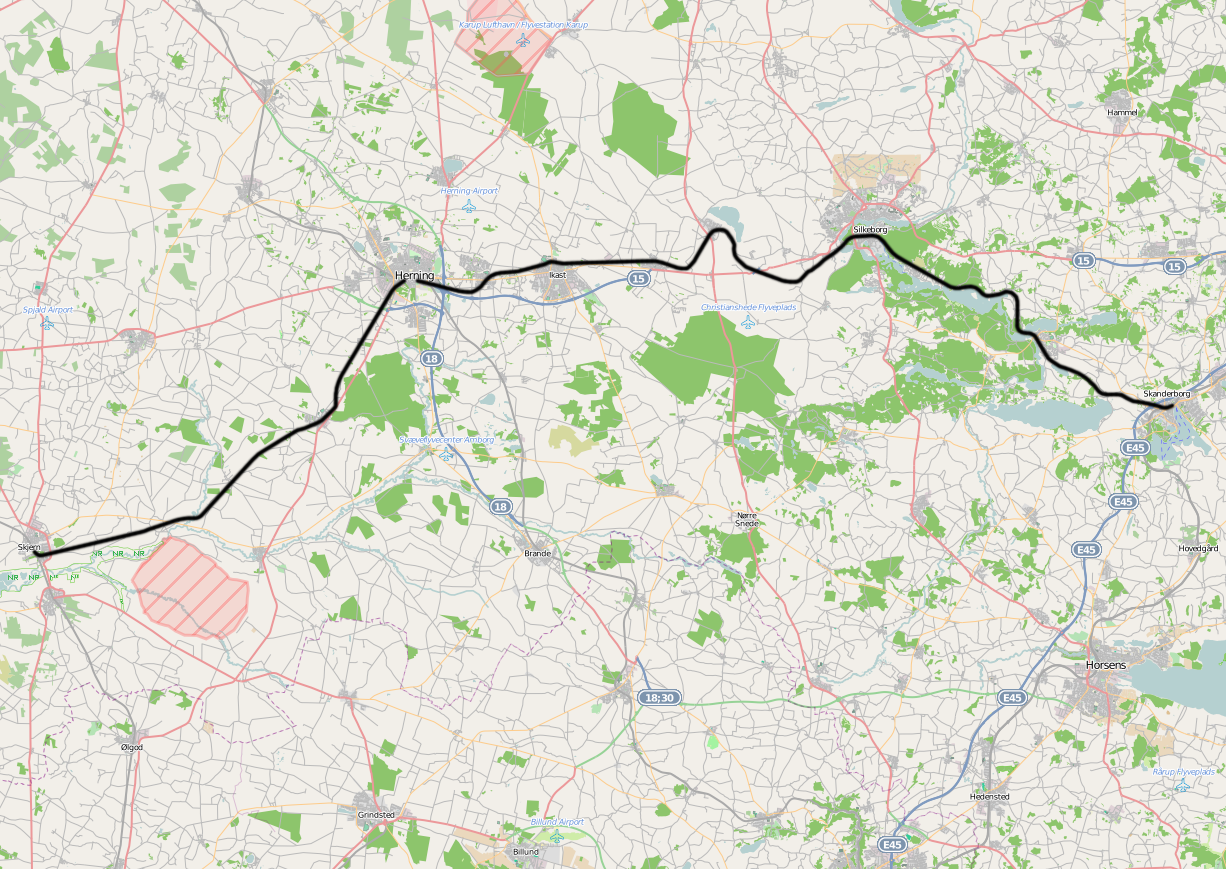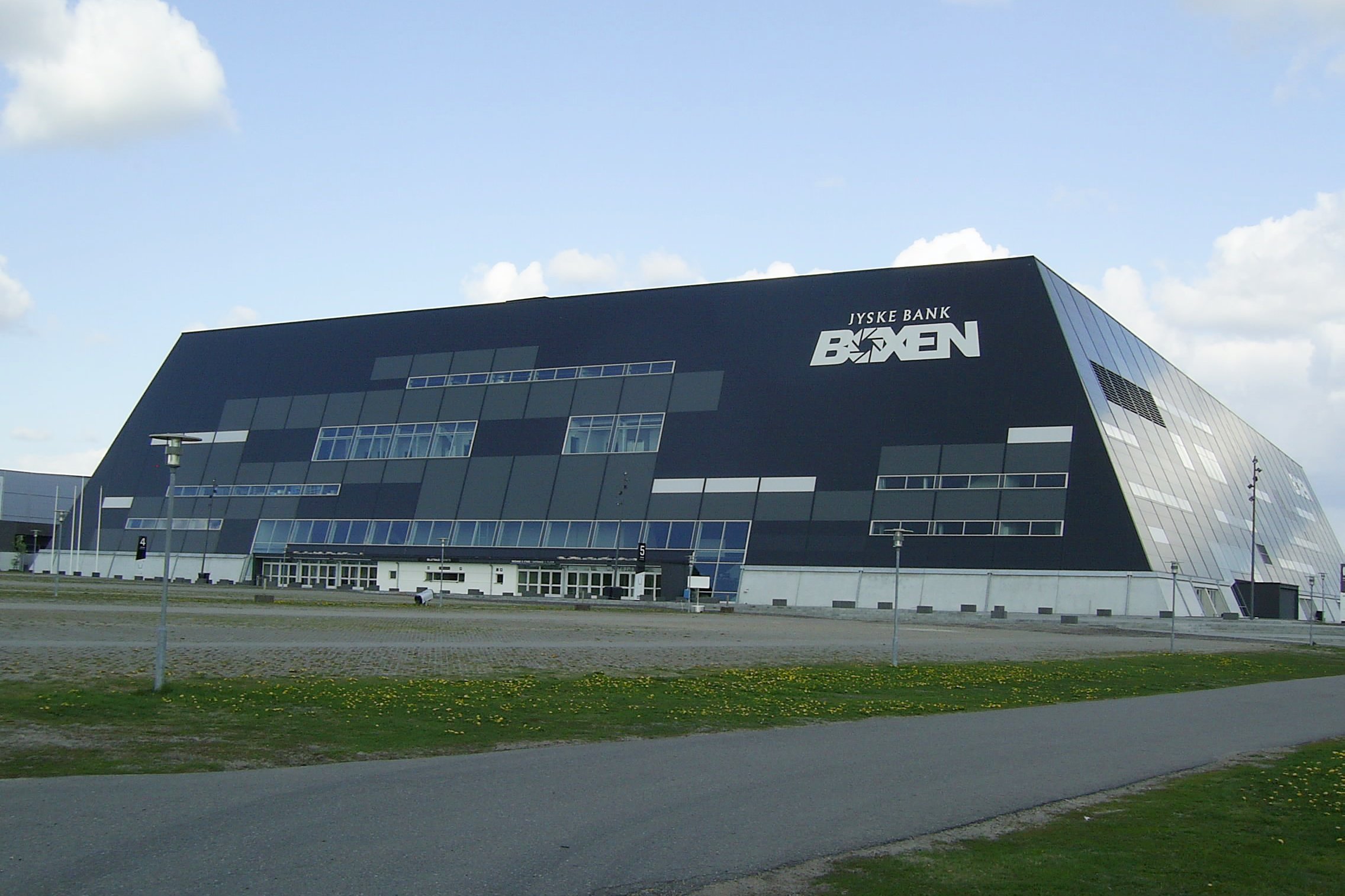|
Skanderborg–Skjern Line
The Skanderborg–Skjern railway line ( da, Skanderborg–Skjern–banen) is a long standard gauge Single-track railway, single track railway line in Denmark which runs between the cities of Skanderborg and Skjern, Denmark, Skjern in Central Jutland, Denmark. The railway opened in sections. The section from Skanderborg to Silkeborg opened in 1871, the section from Silkeborg to Herning in 1877, and the section from Herning to Skjern, Denmark, Skjern in 1881. The line is owned and maintained by Banedanmark, Rail Net Denmark and served with passenger trains by the railway company Arriva. Stations * * * * * * * * * * * * * * * * * * External links BanedanmarkArriva References Citations Bibliography * Railway lines in Denmark Railway lines opened in 1871 Railway lines opened in 1877 Railway lines opened in 1881 1871 establishments in Denmark 1877 establishments in Denmark 1881 establishments in Denmark Rail transport in the Central Denmark ... [...More Info...] [...Related Items...] OR: [Wikipedia] [Google] [Baidu] |
Main Line (railway)
The main line, or mainline in American English, of a railway is a track that is used for through trains or is the principal artery of the system from which branch lines, yards, sidings and spurs are connected. It generally refers to a route between towns, as opposed to a route providing suburban or metro services. It may also be called a trunk line, for example the Grand Trunk Railway in Canada, the Trunk Line in Norway, and the Trunk Line Bridge No. 237 in the United States. For capacity reasons, main lines in many countries have at least a double track and often contain multiple parallel tracks. Main line tracks are typically operated at higher speeds than branch lines and are generally built and maintained to a higher standard than yards and branch lines. Main lines may also be operated under shared access by a number of railway companies, with sidings and branches operated by private companies or single railway companies. Railway points (UK) or switches (US) are usuall ... [...More Info...] [...Related Items...] OR: [Wikipedia] [Google] [Baidu] |
Passenger Train
A passenger train is a train used to transport people along a railroad line. These trains may consist of unpowered passenger railroad cars (also known as coaches or carriages) hauled by one or more locomotives, or may be self-propelled; self propelled passenger trains are known as multiple units or railcars. Passenger trains stop at stations or depots, where passengers may board and disembark. In most cases, passenger trains operate on a fixed schedule and have priority over freight trains. Passenger trains may be made up of a number of passenger cars hauled by one or more locomotives, or may be made up of self-propelled railcars. Car design and the general safety of passenger trains have dramatically evolved over time, making travel by rail remarkably safe. Some passenger trains, both long-distance and short-distance, use bi-level (double-decker) cars to carry more passengers per train. Passenger trains hauled by locomotives are more expensive to operate than multiple uni ... [...More Info...] [...Related Items...] OR: [Wikipedia] [Google] [Baidu] |
1877 Establishments In Denmark
Events January–March * January 1 – Queen Victoria is proclaimed ''Empress of India'' by the ''Royal Titles Act 1876'', introduced by Benjamin Disraeli, the Prime Minister of the United Kingdom . * January 8 – Great Sioux War of 1876 – Battle of Wolf Mountain: Crazy Horse and his warriors fight their last battle with the United States Cavalry in Montana. * January 20 – The Conference of Constantinople ends, with Ottoman Turkey rejecting proposals of internal reform and Balkan provisions. * January 29 – The Satsuma Rebellion, a revolt of disaffected samurai in Japan, breaks out against the new imperial government; it lasts until September, when it is crushed by a professionally led army of draftees. * February 17 – Major General Charles George Gordon of the British Army is appointed Governor-General of the Sudan. * March – ''The Nineteenth Century'' magazine is founded in London. * March 2 – Compromise of 1877: T ... [...More Info...] [...Related Items...] OR: [Wikipedia] [Google] [Baidu] |
1871 Establishments In Denmark
Events January–March * January 3 – Franco-Prussian War – Battle of Bapaume: Prussians win a strategic victory. * January 18 – Proclamation of the German Empire: The member states of the North German Confederation and the south German states, aside from Austria, unite into a single nation state, known as the German Empire. The King of Prussia is declared the first German Emperor as Wilhelm I of Germany, in the Hall of Mirrors at the Palace of Versailles. Constitution of the German Confederation comes into effect. It abolishes all restrictions on Jewish marriage, choice of occupation, place of residence, and property ownership, but exclusion from government employment and discrimination in social relations remain in effect. * January 21 – Giuseppe Garibaldi's group of French and Italian volunteer troops, in support of the French Third Republic, win a battle against the Prussians in the Battle of Dijon. * February 8 – 1871 French legislative election elects ... [...More Info...] [...Related Items...] OR: [Wikipedia] [Google] [Baidu] |
Railway Lines Opened In 1881
Rail transport (also known as train transport) is a means of transport that transfers passengers and goods on wheeled vehicles running on rails, which are incorporated in tracks. In contrast to road transport, where the vehicles run on a prepared flat surface, rail vehicles (rolling stock) are directionally guided by the tracks on which they run. Tracks usually consist of steel rails, installed on sleepers (ties) set in ballast, on which the rolling stock, usually fitted with metal wheels, moves. Other variations are also possible, such as "slab track", in which the rails are fastened to a concrete foundation resting on a prepared subsurface. Rolling stock in a rail transport system generally encounters lower frictional resistance than rubber-tyred road vehicles, so passenger and freight cars (carriages and wagons) can be coupled into longer trains. The operation is carried out by a railway company, providing transport between train stations or freight customer faciliti ... [...More Info...] [...Related Items...] OR: [Wikipedia] [Google] [Baidu] |
Railway Lines Opened In 1877
Rail transport (also known as train transport) is a means of transport that transfers passengers and goods on wheeled vehicles running on rails, which are incorporated in tracks. In contrast to road transport, where the vehicles run on a prepared flat surface, rail vehicles (rolling stock) are directionally guided by the tracks on which they run. Tracks usually consist of steel rails, installed on sleepers (ties) set in ballast, on which the rolling stock, usually fitted with metal wheels, moves. Other variations are also possible, such as "slab track", in which the rails are fastened to a concrete foundation resting on a prepared subsurface. Rolling stock in a rail transport system generally encounters lower frictional resistance than rubber-tyred road vehicles, so passenger and freight cars (carriages and wagons) can be coupled into longer trains. The operation is carried out by a railway company, providing transport between train stations or freight customer facil ... [...More Info...] [...Related Items...] OR: [Wikipedia] [Google] [Baidu] |
Railway Lines Opened In 1871
Rail transport (also known as train transport) is a means of transport that transfers passengers and goods on wheeled vehicles running on rails, which are incorporated in tracks. In contrast to road transport, where the vehicles run on a prepared flat surface, rail vehicles (rolling stock) are directionally guided by the tracks on which they run. Tracks usually consist of steel rails, installed on sleepers (ties) set in ballast, on which the rolling stock, usually fitted with metal wheels, moves. Other variations are also possible, such as "slab track", in which the rails are fastened to a concrete foundation resting on a prepared subsurface. Rolling stock in a rail transport system generally encounters lower frictional resistance than rubber-tyred road vehicles, so passenger and freight cars (carriages and wagons) can be coupled into longer trains. The operation is carried out by a railway company, providing transport between train stations or freight customer faciliti ... [...More Info...] [...Related Items...] OR: [Wikipedia] [Google] [Baidu] |
Railway Lines In Denmark
Rail transport (also known as train transport) is a means of transport that transfers passengers and goods on wheeled vehicles running on rails, which are incorporated in tracks. In contrast to road transport, where the vehicles run on a prepared flat surface, rail vehicles (rolling stock) are directionally guided by the tracks on which they run. Tracks usually consist of steel rails, installed on sleepers (ties) set in ballast, on which the rolling stock, usually fitted with metal wheels, moves. Other variations are also possible, such as "slab track", in which the rails are fastened to a concrete foundation resting on a prepared subsurface. Rolling stock in a rail transport system generally encounters lower frictional resistance than rubber-tyred road vehicles, so passenger and freight cars (carriages and wagons) can be coupled into longer trains. The operation is carried out by a railway company, providing transport between train stations or freight customer facili ... [...More Info...] [...Related Items...] OR: [Wikipedia] [Google] [Baidu] |
Copenhagen
Copenhagen ( or .; da, København ) is the capital and most populous city of Denmark, with a proper population of around 815.000 in the last quarter of 2022; and some 1.370,000 in the urban area; and the wider Copenhagen metropolitan area has 2,057,142 people. Copenhagen is on the islands of Zealand and Amager, separated from Malmö, Sweden, by the Øresund strait. The Øresund Bridge connects the two cities by rail and road. Originally a Viking fishing village established in the 10th century in the vicinity of what is now Gammel Strand, Copenhagen became the capital of Denmark in the early 15th century. Beginning in the 17th century, it consolidated its position as a regional centre of power with its institutions, defences, and armed forces. During the Renaissance the city served as the de facto capital of the Kalmar Union, being the seat of monarchy, governing the majority of the present day Nordic region in a personal union with Sweden and Norway ruled by the Danis ... [...More Info...] [...Related Items...] OR: [Wikipedia] [Google] [Baidu] |
Skjern Station
Skjern may refer to: * Skjern Municipality, a former municipality in Region Midtjylland in west Denmark * Skjern River, the largest river in Denmark by volume * Skjern, Denmark Skjern is a railway town located in western Jutland, Denmark with a population of 7,862 (1 January 2022). [...More Info...] [...Related Items...] OR: [Wikipedia] [Google] [Baidu] |
Herning Station 15
Herning () is a Danish town in the Central Denmark Region of the Jutland peninsula. It is the main town and the administrative seat of Herning Municipality. Herning has a population of 50,565 (1 January 2022)BY3: Population 1st January by urban areas, area and population density The Mobile Statbank from including the suburbs of Tjørring, Snejbjerg, Lind, Birk, Hammerum, and Gjellerup, making Herning the 11th most populous urban area in Denmark. History Herning was established at the beginning of the 1790s, during the peri ...[...More Info...] [...Related Items...] OR: [Wikipedia] [Google] [Baidu] |
Silkeborg Station
Silkeborg station ( da, Silkeborg Station or da, Silkeborg Banegård) is a railway station serving the town of Silkeborg in Central Jutland, Denmark. The station is located on the Skanderborg–Skjern railway line from Skanderborg to Skjern. The station opened in 1871 with the Skanderborg-Silkeborg section of the Skanderborg-Skjern railway. The train services are currently operated by Arriva which run frequent regional train services between Aarhus and Herning Herning () is a Danish town in the Central Denmark Region of the Jutland peninsula. It is the main town and the administrative seat of Herning Municipality. Herning has a population of 50,565 (1 January 2022)Niels ... [...More Info...] [...Related Items...] OR: [Wikipedia] [Google] [Baidu] |


_(LOC)_-_Flickr_-_The_Library_of_Congress.jpg)



